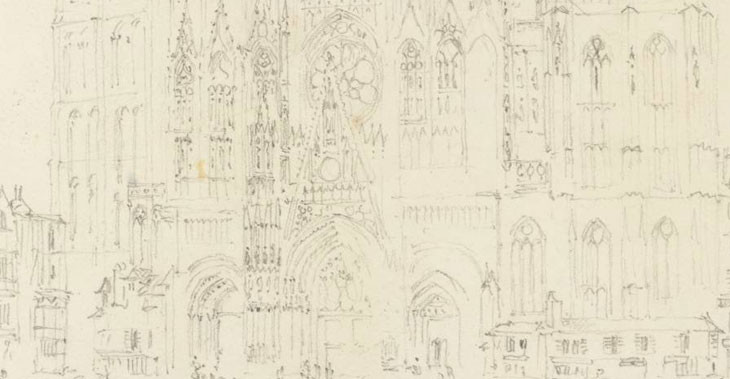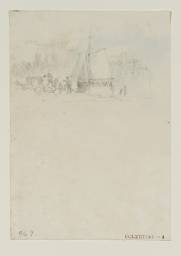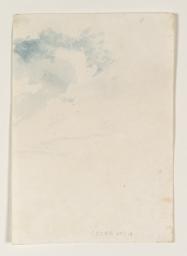Tour of Northern France 1821

From the entry
There are several clues to dating Turner’s tour of Northern France and the Seine to 1821, as depicted in the Paris, Seine and Dieppe Sketchbook, 1821 and the Dieppe, Rouen and Paris Sketchbook, 1821. The pages of these books are watermarked 1820 and 1819 respectively, and, as Ian Warrell points out, Turner’s inclusion of these books in his stock-check of 1824 confirms their use before this date. More specifically, Finberg noted that sketches of Rouen Cathedral in the Dieppe, Rouen and Paris sketchbook depict the spire in the form it had before it was destroyed on 15 September 1822, while a reference to Joseph Farington in the Paris, Seine, and Dieppe book points to a date no later than 1821 as the artist died that year. On the opposite page of the same book is an account of watercolour subjects for Walter Fawkes, including several dated to 1821 (see Tate D18525; Turner Bequest CCXI 1). The most probably date for this tour is therefore the autumn of 1821. Turner does not seem to have had ...
Paris, Seine and Dieppe sketchbook 1821
D18525–D18568; D18571–D18590; D40975–D40977 complete group
Turner Bequest CCXI
D18525–D18568; D18571–D18590; D40975–D40977 complete group
Turner Bequest CCXI
A Group of Boats at Rouen 1821
D25519
Turner Bequest CCLXIII a 4
D25519
Turner Bequest CCLXIII a 4
Part of Sky 1821
D40311
D40311
References
There are several clues to dating Turner’s tour of Northern France and the Seine to 1821, as depicted in the Paris, Seine and Dieppe Sketchbook, 1821 and the Dieppe, Rouen and Paris Sketchbook, 1821. The pages of these books are watermarked 1820 and 1819 respectively, and, as Ian Warrell points out, Turner’s inclusion of these books in his stock-check of 1824 confirms their use before this date.1 More specifically, Finberg noted that sketches of Rouen Cathedral in the Dieppe, Rouen and Paris sketchbook depict the spire in the form it had before it was destroyed on 15 September 1822,2 while a reference to Joseph Farington in the Paris, Seine, and Dieppe book points to a date no later than 1821 as the artist died that year.3 On the opposite page of the same book is an account of watercolour subjects for Walter Fawkes, including several dated to 1821 (see Tate D18525; Turner Bequest CCXI 1). The most probably date for this tour is therefore the autumn of 1821.
Turner does not seem to have had a particular project in mind as the result of this tour, but Ian Warrell has suggested that his interest in French scenery at this time may have been stimulated by the steadily increasing attention paid to Normandy among contemporary British artists and travellers, many of whom exhibited or published views of the region by 1821. The antiquarian interest in the Gothic architecture of Rouen among these contemporaries was a particular spur to Turner who gave special attention to this subject, making finely observed architectural studies.4 Several landscape views and motifs, such as the Seine from Saint-Cloud and the aqueduct at Arcueil, obviously struck Turner with their potential. This was also his first experience of the long stretch of the Seine from Paris to Le Havre, where he drew many of the sites that he would later return to in connection to the Wanderings by the Seine volume of the topographical publication Turner’s Annual Tour, 1833–5. His interest in the unique character of Normandy was also explored in his many figure studies, where he paid particular attention to their distinctive costume (most notably the women’s hats), and to the quayside activity that he witnessed at several harbours.
John Ruskin’s dismantlement of both sketchbooks, and their subsequent rebinding out of order, means that any evidence to be gained by the order of pages has been lost. However, Ian Warrell has demonstrated that sequences of sketches of the Seine on the same page indicate that Turner travelled down-river between Rouen and Le Havre, enabling him to suggest a route for the rest of the tour.5 Several sketches of Brighton from the sea on a page of the Paris, Seine and Dieppe sketchbook indicated a journey away from the town (Tate D18546; Turner Bequest CCXI 14a), suggesting that Turner sailed from there to Dieppe. From Dieppe he travelled south by road to Rouen. Sketches of a type of public coach called a diligence at both Dieppe (Tate D24530; Turner Bequest CCLVIII 16) and Rouen (Tate D24500; Turner Bequest CCLVIII 1) suggest his mode of transportation. From Rouen Turner travelled to Paris and its suburbs, before returning to Rouen to begin his journey along the Seine to Le Havre.6 Rather than setting sail for England from Le Havre, sketches at Abbeville (Tate D18582; Turner Bequest CCXI 37a) and Dover (Tate D18526; Turner Bequest CCXI 1a) indicate that he travelled north by road to Calais and returned to England from there.
How to cite
Thomas Ardill, ‘Tour of Northern France 1821’, March 2013, in David Blayney Brown (ed.), J.M.W. Turner: Sketchbooks, Drawings and Watercolours, Tate Research Publication, August 2014, https://www




